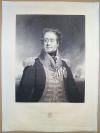Sir Richard King, 2nd Baronet facts for kids
Quick facts for kids
Sir Richard King, Bt
|
|
|---|---|
 |
|
| Born | 28 November 1774 Maypowder, Dorset, England |
| Died | 5 August 1834 (aged 59) Sheerness, Kent, England |
| Buried |
All Saints Church, Eastchurch, Isle of Sheppey, England
|
| Allegiance | |
| Service/ |
|
| Rank | Vice-Admiral |
| Commands held | HMS Sirius HMS Achille East Indies Station Nore Command |
| Battles/wars | French Revolutionary Wars Napoleonic Wars |
| Awards | Knight Commander of the Order of the Bath |
Vice Admiral Sir Richard King, 2nd Baronet (born November 28, 1774 – died August 5, 1834) was a brave officer in the Royal Navy. He served during the French Revolutionary and Napoleonic Wars. He was known for fighting very well at the famous Battle of Trafalgar, even though he was one of the youngest captains there.
Contents
Richard King was the son of Sir Richard King, 1st Baronet, who was also a very important person in the Navy. Young Richard joined the Navy when he was just fourteen years old. Because of his father's high rank, he became a "Post Captain" only six years later. This was a very fast promotion, as most officers had to wait much longer.
Even though he got promoted quickly, King was a very skilled officer. He proved his abilities as the captain of HMS Sirius. While in command of Sirius, he captured four enemy ships. He also helped make important decisions for the Navy. In 1798, he captured two Dutch ships. In 1801, he captured a French warship. Because of his successes, he was given command of a large 74-gun warship called HMS Achille.
The Battle of Trafalgar
In 1805, a big battle was about to happen near Cadiz. Captain King wanted to be part of it. He used his connections to join the British fleet led by Admiral Nelson. Nelson agreed because King had a good reputation. King joined the fleet just in time for the Battle of Trafalgar on October 21, 1805.
His ship, Achille, was the seventh ship in Admiral Collingwood's group. Achille fought bravely, chasing away the Spanish ship Montañés. She also battled alongside HMS Belleisle against the Spanish ship Argonauta. While chasing the Argonauta, Achille was suddenly attacked by a French ship also named Achille. They fought fiercely. Then, another French ship, Berwick, joined the fight. Achille turned her attention to the Berwick. After an hour of intense fighting, the French Berwick had to surrender. The battle was tough for Achille, with 13 sailors killed and 59 wounded.
After Trafalgar and Later Career
After the Battle of Trafalgar, Captain King received many honors, just like the other captains. Unlike some, he kept his command at sea. The next year, he was involved in another battle against a group of French warships. In this fight, Sir Samuel Hood lost an arm.
In the same year, 1806, King inherited his father's title, becoming the 2nd Baronet. He then moved to the Mediterranean Sea. In 1812, he was promoted to Rear-Admiral and became second-in-command to Edward Pellew. He received another important award, the KCB, in 1815. From 1816, he was the commander-in-chief of the British Navy in the East Indies Station.
King continued his successful career even after the wars ended. In 1819, he became a Vice-Admiral. From 1833, he served as the Commander-in-Chief at The Nore. Many officers retired at his age, but King kept working.
Family Life
Sir Richard King had two wives and many children. His first wife was Sarah Anne Duckworth. They had four sons and one daughter. Two of their sons, Richard Duckworth King and George St Vincent King, later became baronets like their father.
His second wife was Maria Susannah. With her, he had four more sons and three daughters.
Death
Sir Richard King died in 1834 while still serving in the Navy. He passed away suddenly in Sheerness from a disease called cholera. He was buried nearby. He was survived by his second wife and twelve children.

